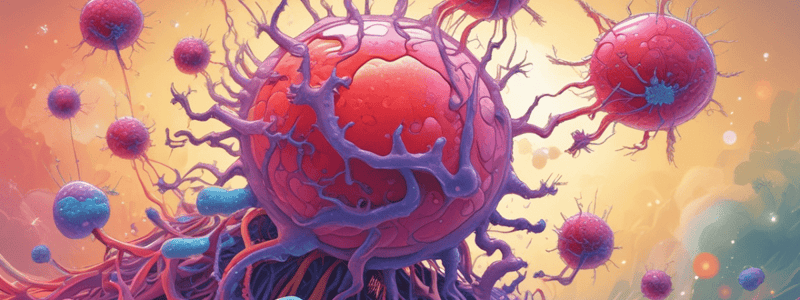Podcast
Questions and Answers
Which granulocyte is most abundant in peripheral blood?
Which granulocyte is most abundant in peripheral blood?
- Monocytes
- Basophils
- Neutrophils (correct)
- Eosinophils
Which granulocyte is characterized by a bi-lobed nucleus and acidophilic granules?
Which granulocyte is characterized by a bi-lobed nucleus and acidophilic granules?
- Eosinophils (correct)
- Basophils
- Neutrophils
- Lymphocytes
What is the primary function of eosinophils?
What is the primary function of eosinophils?
- Support mast cells
- Anti-bacterial responses
- Phagocytosis of bacteria
- Mediate hypersensitivity reactions and eliminate helminth worms (correct)
Which cells are highly phagocytic?
Which cells are highly phagocytic?
What chemicals do basophils release during hypersensitivity reactions?
What chemicals do basophils release during hypersensitivity reactions?
Which cell's nucleus is often obscured by specific granules?
Which cell's nucleus is often obscured by specific granules?
What is the primary function of dendritic cells in the immune system?
What is the primary function of dendritic cells in the immune system?
What is another name for the reticuloendothelial system (RES)?
What is another name for the reticuloendothelial system (RES)?
Which of the following is NOT a function of dendritic cells?
Which of the following is NOT a function of dendritic cells?
Where are interdigitating dendritic cells primarily found?
Where are interdigitating dendritic cells primarily found?
Which statement is true about follicular dendritic cells?
Which statement is true about follicular dendritic cells?
Which cell type is responsible for antigen presentation to T cells?
Which cell type is responsible for antigen presentation to T cells?
What are the two arms of the immune response?
What are the two arms of the immune response?
What describes the innate response in the immune system?
What describes the innate response in the immune system?
Which cells are the blood precursors of tissue macrophages?
Which cells are the blood precursors of tissue macrophages?
Which mechanism involves cytotoxic T cells and phagocytes?
Which mechanism involves cytotoxic T cells and phagocytes?
What characteristic is shared by both innate and adaptive immune responses?
What characteristic is shared by both innate and adaptive immune responses?
From where do mononuclear phagocytes originate and circulate as monocytes?
From where do mononuclear phagocytes originate and circulate as monocytes?
What is the typical lifespan of a monocyte in the blood?
What is the typical lifespan of a monocyte in the blood?
Which of the following completes their maturation in the thymus?
Which of the following completes their maturation in the thymus?
Flashcards are hidden until you start studying
Study Notes
Cells of the Immune System
- Mononuclear phagocytes:
- Also known as reticuloendothelial cells
- Function in phagocytosis, production of inflammatory mediators, and presentation of antigen to T cells
- Mediate both innate and adaptive responses
Dendritic Cells
- Accessory cells that induce the adaptive response
- Two main types: interdigitating dendritic cells and follicular dendritic cells
- Found in most organs, epidermis of skin, and lymphatic tissue
- Thought to arise from marrow precursors related to mononuclear phagocytic system
- Functions: pick up antigens, transport them to lymph nodes, present antigen to T cells, and mediate adaptive responses
Granulocytes
- Contain abundant cytoplasmic granules
- Include neutrophils, eosinophils, and basophils
Neutrophils
- Multi-lobed (3-5 lobes) morphologically diverse nuclei
- Most abundant granulocyte (2.5-7.5 x 10^9/l)
- 12-15 µm diameter, life span 10 h (blood), days in tissues
- Highly phagocytic, key cells in anti-bacterial responses
- Mediate innate response and support adaptive responses
Basophils
- Basophilic granules
- Mediate hypersensitivity reactions through release of chemicals such as histamine
- 0.01-0.1 x 10^9/l, only occasionally seen in normal peripheral blood
- Nucleus obscured by basophilic specific granules
Eosinophils
- Bi-lobed nucleus and acidophilic granules
- 0.04-0.4 x 10^9/l, life span = 2 weeks
- Acidic-staining granules that bind eosin and stain orange
- Granules contain major basic protein
- Functions: elimination of infectious agents such as helminth worms, mediate hypersensitivity (allergic) reactions, and mediate adaptive responses
Mast Cells
- Dark basic staining granules containing heparin and histamine, stain purple
- Functions: support mast cells in tissues, mediate allergic reactions, and mediate adaptive responses
Introduction to the Immune System
- Immunology is the study of immunity
- Two arms to the immune response: innate response and adaptive response
- Innate response: first line of defense, non-specific, no memory
- Adaptive response: final stage of immune response, specific, memory
Mononuclear Phagocytes
- Originate in BM and enter the peripheral blood as monocytes
- Monocytes leave the circulation and enter tissues where they mature into macrophages (histiocytes)
- Functions: effector mechanisms utilized by innate and adaptive responses are the same
Effector Mechanisms
- Mechanisms by which harmful agents are destroyed by the immune system
- Can be both cell-mediated and humoral
- Examples: cytotoxic T cell, phagocyte, natural killer cell, complement, cytokines, acute phase proteins, and antibodies
Studying That Suits You
Use AI to generate personalized quizzes and flashcards to suit your learning preferences.




